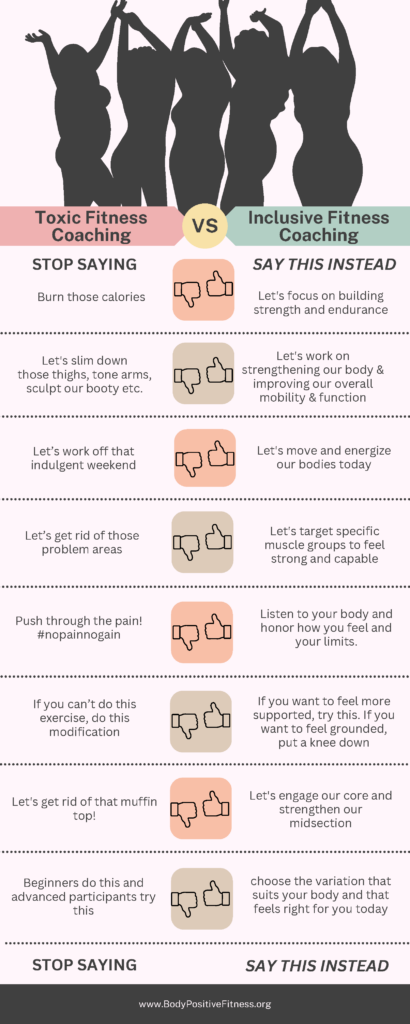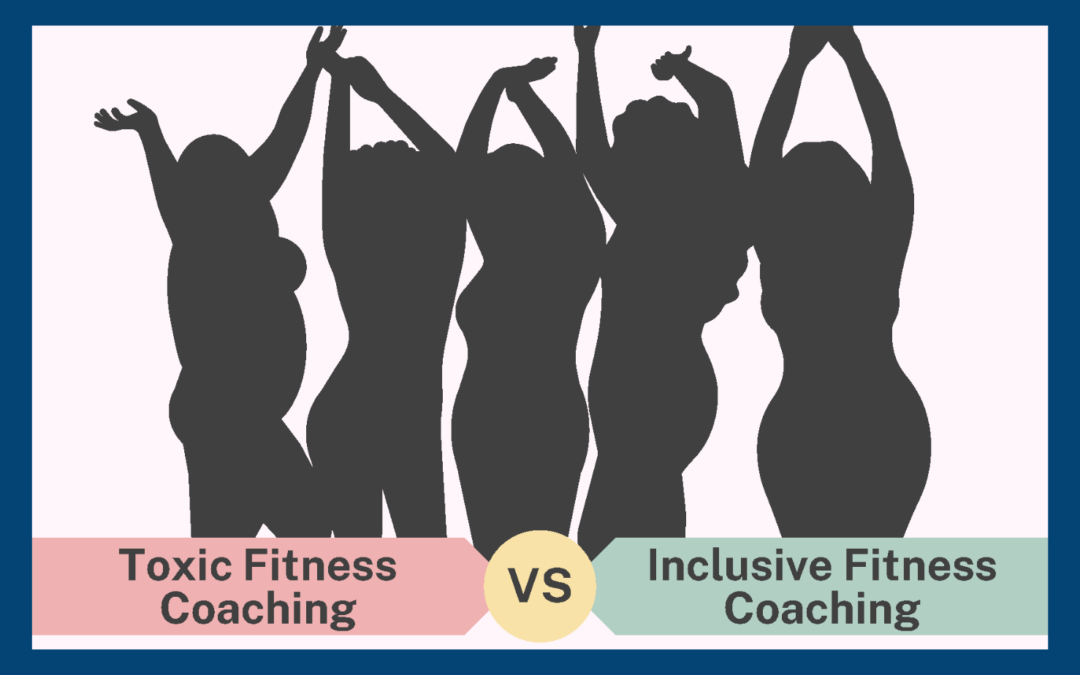By BPFA Board Member Christine DeFilippis
In the vibrant world of group fitness, our words hold immense power – they can either uplift and inspire or they can deflate and discourage participants. As advocates for inclusivity and body positivity, it’s paramount that we recognize and harness this power for the betterment of our community. In this blog, we delve into four key areas to foster inclusivity and respect within our classes.
Being Aware That Our Words Have Power:
Our language serves as a potent tool that shapes perceptions, influences self-esteem, and molds attitudes. Negative language perpetuates harmful stereotypes and fosters exclusion, while positive language cultivates a supportive environment where everyone feels valued and encouraged.

Mistake 1: Coupling food and fitness
Fitness spaces should serve as sanctuaries free from judgment and guilt, yet the integration of food-related cues can inadvertently perpetuate harmful attitudes towards eating and body image. By refraining from associating exercise with food morality, we foster an environment where participants can focus solely on movement and wellness.
Instead of: “Work off that indulgent weekend!”
Say this instead: “Let’s move and energize our bodies today, focusing on feeling strong and vibrant.”
By separating food from fitness instruction, we honor the diverse needs and experiences of our participants, promoting a culture of acceptance and self-care.
Mistake 2: Creating Levels in Classes
In many group fitness classes, instructors may unintentionally perpetuate exclusion by categorizing exercises into “levels.” While the intention behind this may be to provide options for participants of varying fitness levels, it can inadvertently create a sense of hierarchy and inadequacy among participants. This approach often assumes that certain exercises are inherently more challenging or superior to others, leading to feelings of frustration or disengagement among participants who may not identify with the designated level.
For example, consider the cue: “Beginners, stick to the modified versions, while advanced participants can attempt the full version.” While this may seem like a logical way to cater to different fitness levels, it can inadvertently reinforce the idea that modified versions are inferior or only suitable for beginners. This can create a sense of stigma around modifications and discourage participants from listening to their bodies and choosing options that best suit their individual needs.
Instead of categorizing exercises into levels, instructors can adopt a more inclusive approach by providing a range of options and encouraging participants to explore what feels best for their bodies. Rather than labeling exercises as “beginner,” “intermediate,” or “advanced,” consider cues that empower participants to make choices based on their own comfort and capability.
For example, instead of segregating participants into distinct levels, instructors can offer variations for each exercise and encourage participants to choose the option that allows them to challenge themselves while maintaining proper form and alignment. Phrases like, “Feel free to choose the variation that suits your body today,” or “Listen to your body and select the option that feels right for you,” empower participants to take ownership of their fitness journey and make choices that honor their individual strengths and limitations.
By moving away from a hierarchical approach to exercise and embracing inclusivity through offering options and encouraging autonomy, instructors can create a more welcoming and empowering environment where all participants feel valued and supported in their fitness journey.
Mistake 3: Toxic Fitness Culture: All or Nothing Mentality:
The pervasive “go hard or go home” mentality in fitness can alienate individuals who may not meet traditional fitness standards or have physical limitations. This toxic culture promotes an all-or-nothing approach that prioritizes intensity over sustainability and ignores the diverse needs of participants. Instead, let’s cultivate an environment that celebrates progress and honors individual boundaries.
Instead of: “If you can’t do this exercise, do this modification”
Try this: “If you want to feel more supported, try this. When teaching a plank for example rather than say if you can’t do it on your toes, put a knee down, you could instead say: “If you want to feel grounded, put a knee down.”
The goal is to encourage the use of modifications and provide options for participants of all fitness levels emphasizing the importance of consistency and gradual progress over perfection.
Celebrating every small victory, whether it’s mastering a new move or simply showing up for class. By rejecting toxic fitness culture and embracing inclusivity, we create spaces where all individuals feel welcomed and empowered to embark on their fitness journey at their own pace.
Mistake 4: Focusing on Aesthetics vs fitness & health benefits
In fitness, the way we look is often confused for our actual fitness level. When we coach in a way that puts the focus on changing the way our body looks, we are missing out on focusing on non-aesthetic wins. Instead, let’s celebrate what our bodies can do and work towards feeling strong and capable in every movement. In many group fitness classes, the focus is often solely on achieving a certain aesthetic ideal, which can perpetuate harmful notions of beauty and body image. By shifting the focus to the holistic benefits of fitness – such as improved strength, flexibility, and mental well-being – we empower participants to appreciate their bodies for what they can do rather than how they look.
Consider reframing cues such as: “Let’s slim down those thighs!” To instead, “Let’s work on strengthening our lower body and improving our overall mobility and function.”
By celebrating the diverse abilities and accomplishments of our bodies, we promote a culture of acceptance and self-love that transcends superficial standards of beauty.
As group fitness instructors, we wield immense influence over the atmosphere and culture of our classes. By embracing mindful language and practices, separating food from fitness, rejecting toxic fitness culture, and focusing on holistic wellness, we pave the way for a more inclusive and empowering fitness community. Let’s continue to educate ourselves, uplift those around us, and strive towards a future where every body feels valued, respected, and celebrated. Through our intentional actions and words, we can create spaces where all individuals, regardless of size, shape, or ability, feel seen, heard, and empowered to thrive. Together, let’s build a fitness community that fosters inclusivity, diversity, and empowerment.

Recent Comments